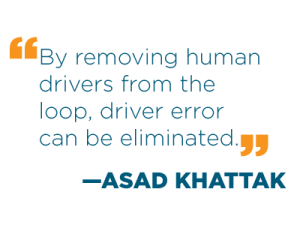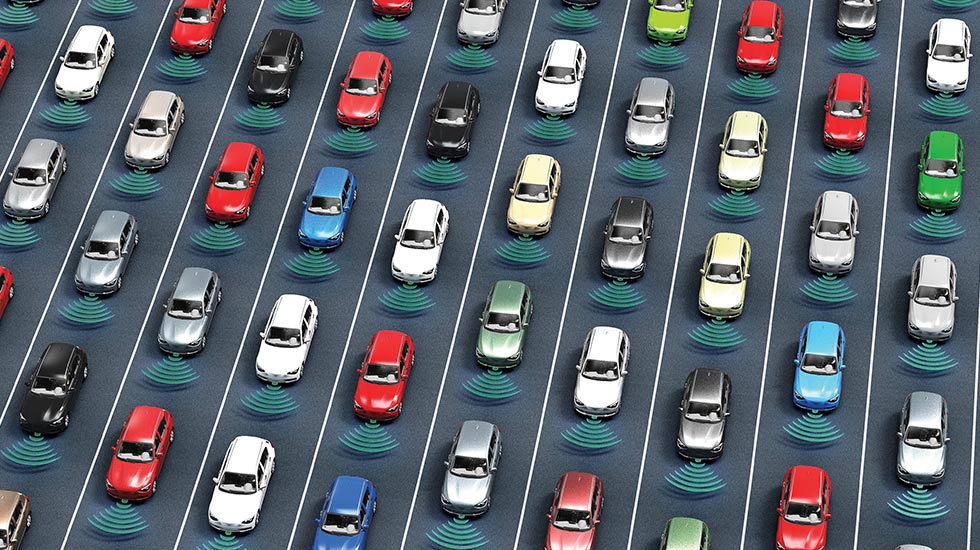Data, Take the Wheel
Connected and autonomous vehicles—driverless cars—are all the rage these days, from Austin to Boston and Detroit to Silicon Valley. Cities are vying to test the technology and stay on the cutting edge of transportation.
In downtown Knoxville near the UT campus, Mayor Madeline Rogero announced in spring 2017 that a self-driving electric trolley will be tested this year, and might be in service as a tourist shuttle as early as 2018.
The driverless revolution seems to be happening fast, but there are speedbumps yet to be crossed. Lawmakers are busy contemplating the types of new regulations that the technology will call for. The phenomenon could influence changes across the culture: new business models, roadway development, insurance policies, and jobs to name a few.
David Clarke, director of the UT’s Center for transportation Research, spoke on the topic earlier with year in a chat broadcast on “The Method,” a science-and-society series on WUOT FM, UT’s public radio station. He pointed out that, while it’s a hot topic in the media, highways full of automated cars are still largely on the drawing board.
“At some point, we may get to a place where autonomous vehicle operation is the norm,” said Clarke. “But I think it’s going to take a while for us to get there.”
There are many practical issues to consider in automating a task as complicated as driving.
“For example, you are approaching an intersection and a policeman is standing there directing traffic, and they are beckoning to you to come forth and make a turn, or slow down or speed up, or something like that,” explained Clarke. “How does a vehicle with technology, as we currently have on hand, have the same level of understanding?”
Autonomous operation in adverse weather is another concern, as is making the technology affordable. A variety of challenges face the driverless revolution, but vital issues motivate the research: improved mobility, energy efficiency, environmental concerns, and—most importantly—safety.

“Their need comes from the huge costs of fatal and non-fatal crashes, where human driver error is the main contributing factor in about 93 percent of the crashes,” said Asad Khattak, Beaman Professor of Civil and Environmental Engineering and Transportation Program Coordinator.
Khattak and fellow transportation engineers at UT are using a unique big-data approach to solving these issues, gathering information from connected and autonomous vehicles and investigating driver behavior. Modern sensors mounted on vehicles and the surrounding transportation infrastructure are used to collect crucial information. Sensor data are uploaded and stored by cities and state transportation agencies. In addition, the US Department of Transportation maintains the Research Data Exchange database, which stores information generated by field operational tests.
“The information often comes from a vehicle’s surroundings and it is processed quickly to take necessary driving actions—much faster than human drivers can,” said Khattak.
Khattak and colleagues have worked on an NSF-sponsored project titled “Driving Volatility in a Connected and Cooperative Vehicle Environment: Algorithms for Driver Warnings and Control Assists.” He is accompanied on the project by UT co-researcher Subhadeep Chakraboorty, an assistant professor in mechanical engineering.
“By using emerging high-resolution connected vehicle data from different nationwide test beds, we are exploring how to reduce driving volatility by generating appropriate driver warning messages,” said Khattak. “Also, using reinforcement learning, we are learning human drivers’ behavior and their preferences at a microscopic level. The outcome of this artificial intelligence research can be applied to facilitate the introduction of automated vehicles into the present transportation system.”
So, like any parent with a new driver in the family, transportation experts at UT are making sure autonomous cars know what they are doing before they let them hit the road.
